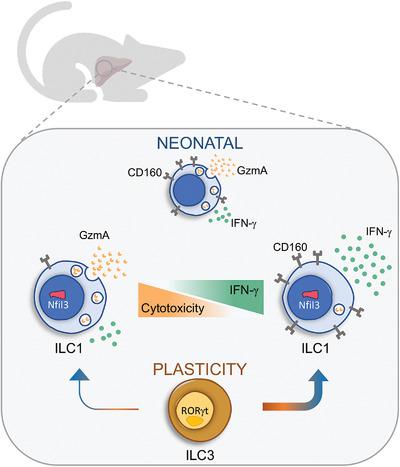当前位置:
X-MOL 学术
›
Eur. J. Immunol.
›
论文详情
Our official English website, www.x-mol.net, welcomes your
feedback! (Note: you will need to create a separate account there.)
Granzyme A and CD160 expression delineates ILC1 with graded functions in the mouse liver
European Journal of Immunology ( IF 4.5 ) Pub Date : 2021-08-04 , DOI: 10.1002/eji.202149209 Chiara Di Censo 1 , Marie Marotel 2, 3, 4 , Irene Mattiola 5, 6, 7 , Lena Müller 8 , Gianluca Scarno 1 , Giuseppe Pietropaolo 1 , Giovanna Peruzzi 9 , Mattia Laffranchi 1 , Julija Mazej 1 , Mohamed Shaad Hasim 2, 3, 4 , Sara Asif 2, 3, 4 , Eleonora Russo 1 , Luana Tomaipitinca 1 , Helena Stabile 1 , Seung-Hwan Lee 3, 4 , Laura Vian 10 , Massimo Gadina 10 , Angela Gismondi 1 , Han-Yu Shih 11 , Yohei Mikami 12 , Cristina Capuano 13 , Giovanni Bernardini 1 , Michael Bonelli 8 , Silvano Sozzani 1, 14 , Andreas Diefenbach 5, 6, 7 , Michele Ardolino 2, 3, 4 , Angela Santoni 1, 14 , Giuseppe Sciumè 1
European Journal of Immunology ( IF 4.5 ) Pub Date : 2021-08-04 , DOI: 10.1002/eji.202149209 Chiara Di Censo 1 , Marie Marotel 2, 3, 4 , Irene Mattiola 5, 6, 7 , Lena Müller 8 , Gianluca Scarno 1 , Giuseppe Pietropaolo 1 , Giovanna Peruzzi 9 , Mattia Laffranchi 1 , Julija Mazej 1 , Mohamed Shaad Hasim 2, 3, 4 , Sara Asif 2, 3, 4 , Eleonora Russo 1 , Luana Tomaipitinca 1 , Helena Stabile 1 , Seung-Hwan Lee 3, 4 , Laura Vian 10 , Massimo Gadina 10 , Angela Gismondi 1 , Han-Yu Shih 11 , Yohei Mikami 12 , Cristina Capuano 13 , Giovanni Bernardini 1 , Michael Bonelli 8 , Silvano Sozzani 1, 14 , Andreas Diefenbach 5, 6, 7 , Michele Ardolino 2, 3, 4 , Angela Santoni 1, 14 , Giuseppe Sciumè 1
Affiliation

|
Type 1 innate lymphoid cells (ILC1) are tissue-resident lymphocytes that provide early protection against bacterial and viral infections. Discrete transcriptional states of ILC1 have been identified in homeostatic and pathological contexts. However, whether these states delineate ILC1 with different functional properties is not completely understood. Here, we show that liver ILC1 are heterogeneous for the expression of distinct effector molecules and surface receptors, including granzyme A (GzmA) and CD160, in mice. ILC1 expressing high levels of GzmA are enriched in the liver of adult mice, and represent the main hepatic ILC1 population at birth. However, the heterogeneity of GzmA and CD160 expression in hepatic ILC1 begins perinatally and increases with age. GzmA+ ILC1 differ from NK cells for the limited homeostatic requirements of JAK/STAT signals and the transcription factor Nfil3. Moreover, by employing Rorc(γt)-fate map (fm) reporter mice, we established that ILC3-ILC1 plasticity contributes to delineate the heterogeneity of liver ILC1, with RORγt-fm+ cells skewed toward a GzmA–CD160+ phenotype. Finally, we showed that ILC1 defined by the expression of GzmA and CD160 are characterized by graded cytotoxic potential and ability to produce IFN-γ. In conclusion, our findings help deconvoluting ILC1 heterogeneity and provide evidence for functional diversification of liver ILC1.
中文翻译:

粒酶 A 和 CD160 表达描绘了小鼠肝脏中具有分级功能的 ILC1
1 型先天淋巴细胞 (ILC1) 是组织驻留淋巴细胞,可提供早期保护,防止细菌和病毒感染。ILC1 的离散转录状态已在稳态和病理环境中被确定。然而,这些状态是否描绘了具有不同功能特性的 ILC1 尚不完全清楚。在这里,我们表明肝脏 ILC1 在小鼠中表达不同的效应分子和表面受体(包括颗粒酶 A (GzmA) 和 CD160)是异质的。表达高水平 GzmA 的 ILC1 在成年小鼠的肝脏中富集,并代表出生时的主要肝脏 ILC1 群体。然而,肝脏 ILC1 中 GzmA 和 CD160 表达的异质性在围产期开始并随着年龄的增长而增加。GzmA +ILC1 与 NK 细胞的不同之处在于 JAK/STAT 信号和转录因子Nfil3的有限稳态要求。此外,通过使用Rorc(γt) -fate map (fm) 报告小鼠,我们确定 ILC3-ILC1 可塑性有助于描绘肝脏 ILC1 的异质性,RORγt-fm +细胞倾向于 GzmA - CD160 +表型。最后,我们发现由 GzmA 和 CD160 的表达定义的 ILC1 具有分级的细胞毒性潜力和产生 IFN-γ 的能力。总之,我们的研究结果有助于解卷积 ILC1 的异质性,并为肝脏 ILC1 的功能多样化提供证据。
更新日期:2021-08-04
中文翻译:

粒酶 A 和 CD160 表达描绘了小鼠肝脏中具有分级功能的 ILC1
1 型先天淋巴细胞 (ILC1) 是组织驻留淋巴细胞,可提供早期保护,防止细菌和病毒感染。ILC1 的离散转录状态已在稳态和病理环境中被确定。然而,这些状态是否描绘了具有不同功能特性的 ILC1 尚不完全清楚。在这里,我们表明肝脏 ILC1 在小鼠中表达不同的效应分子和表面受体(包括颗粒酶 A (GzmA) 和 CD160)是异质的。表达高水平 GzmA 的 ILC1 在成年小鼠的肝脏中富集,并代表出生时的主要肝脏 ILC1 群体。然而,肝脏 ILC1 中 GzmA 和 CD160 表达的异质性在围产期开始并随着年龄的增长而增加。GzmA +ILC1 与 NK 细胞的不同之处在于 JAK/STAT 信号和转录因子Nfil3的有限稳态要求。此外,通过使用Rorc(γt) -fate map (fm) 报告小鼠,我们确定 ILC3-ILC1 可塑性有助于描绘肝脏 ILC1 的异质性,RORγt-fm +细胞倾向于 GzmA - CD160 +表型。最后,我们发现由 GzmA 和 CD160 的表达定义的 ILC1 具有分级的细胞毒性潜力和产生 IFN-γ 的能力。总之,我们的研究结果有助于解卷积 ILC1 的异质性,并为肝脏 ILC1 的功能多样化提供证据。











































 京公网安备 11010802027423号
京公网安备 11010802027423号